Review: 2013 Ford Focus ST
When you’ve reviewed over 600 cars, few new ones surprise you. With the polished road manners and granitic structure of a far more expensive car, the 2012 Ford Focus was one of the few. But its 160-horsepower engine, while easily adequate for daily driving, doesn’t provide the thrust many driving enthusiasts demand. For 2013, this should no longer be a problem. A 252-horsepower Ford Focus ST has joined the line.
Some people find the exterior of the Focus overdone, but when shod with large five-spoke alloys it’s the most attractive car in the segment to my eye, with an athletic stance, excellent proportions (for a front-drive hatch), and hardly a line out of place. For the ST, Ford has enhanced the egg with a cleaner front fascia with a black grille, a centrally-located exhaust, and a larger spoiler. Big buck AMGs should be this tasteful.
Inside, Recaro buckets included with either option package are the most noteworthy upgrade (the base ST is fitted with the supportive buckets from the regular Focus). With the ST3 Package, the seating surfaces are entirely covered with charcoal leather. I prefer the partial leather seats in the ST2 Package, as their center panels are covered in a niftily textured fabric and their bolsters inject some much needed color (yellow, blue, or silver). With either option the Recaros provide both excellent lateral support and long-distance comfort (unless you’re too broad for them). The ST also gains some auxiliary gauges atop the center stack. As in other upper trim Foci, interior materials appear of high quality and feel solid.
My least favorite aspects of the regular Focus cannot be altered without a major redesign of the car. The instrument panel remains tall and deep beneath a severely raked windshield. A more open view over a more compact instrument panel would make for a more engaging driving experience. The center console is also more intrusive than most, but this doesn’t bother me like it does some people. If you like a lot of room behind the wheel, the Focus isn’t the car for you.
Move to the back seat, and if you or the driver is much over 5’9″ you’ll wish you hadn’t. Legroom remains short of the segment average. If you aren’t very tall, though, you’ll likely find the rear seat comfortable.
While the regular Focus is available as a sedan and a hatch, in North America the ST is available only in the latter body style. This does make for a practical car, if not as practical as the wagon offered in Europe.
The engine in the Focus ST is no low-volume bespoke mill. It’s also available beneath the hood of most other Ford models, in the larger cars serving not as the high-performance option but as the high-MPG option. For the ST it does kick out another 12 horsepower, for a total of 252 at 5,500 rpm, but this is entirely due to a less restrictive intake and exhaust. The engine itself is physically unchanged. Good things follow. First, as we’ll discuss in more detail below, Ford charges surprisingly little for the ST upgrades. Second, refinement is worthy of a mainstream $30,000+ car. Third, fuel economy is much better than with the most direct competitor. The MazdaSpeed3 has EPA ratings of 18 mpg city, 25 highway. The Focus ST does far better, with guilt-free EPA ratings of 23/32. (These estimates aren’t hard to replicate in the real world if you go easy on the gas.)
As it often does, refinement cuts both ways. There no kick or even a solid shove as boost kicks in. Instead, thrust builds very smoothly, and before you know it, the car is traveling well over 80 mph. Ford fitted a “sound symposer” to pipe intake noise into the cabin at high rpm. Nevertheless, the engine remains sufficiently quiet that a few times while powering out of a turn I felt the engine go limp, briefly wondered if a safety nanny had kicked in, then noticed that I was riding the 6,800-rpm rev limiter. It’s not easy to time shifts without keeping a close eye on the tach. First tops out very quickly. Between this and the tires’ inability to transfer all the engine’s torque to the pavement at low speeds, and ideally first would be a little taller.
While the ST’s peak power figure is actually a little low for a boosted 2.0-liter (likely due to its mainstream role), the engine excels in the midrange, with peak torque of 270 pound-feet at 2,700 rpm. An overboost function unique to this application plumps out the midrange another eight percent for up to 15 seconds. With this much torque channeled entirely through the front wheels, the question isn’t whether there’s torque steer, but how much. Well, there’s enough to mildly tug the steering wheel this way and that during hard acceleration, but not nearly enough that you have to fight to keep the car on your desired line. Hard shifts from first to second also effect a little wheel hop. The shifter and clutch for the mandatory six-speed manual transmission aren’t the best–you’ll read no rifle bolt analogies here–but they commit no notable sins.
There’s enough thrust that hard acceleration provides thrills despite the wet blanket of refinement and the family sedan-like 3,223-pound curb weight. But Ford offers the Mustang for those seeking straight line kicks. The Focus ST is really about handling. Even the regular Focus tackles curvy roads with aplomb. For the ST, Ford has added a variable-ratio steering rack, lowered the suspension a centimeter, firmed up the springs and dampers, totally revised the rear stabilizer bar, enhanced the suspension electronics, and fitted Goodyear Eagle F1 Asymmetric three-season tires (in the same 235/40R18 size also offered on the Titanium). Thanks to these upgrades, the hatch’s handling goes from surprisingly good to amazing. The feel is much the same, with the body control of a much more expensive car, just taken up another couple notches. Between the tires’ extremely high limits, the revised suspension hardware, and the electronic torque vectoring, you’ll have to push the car harder than I was willing to push it on public roads to encounter more than a hint of understeer. On the other hand, lift off the gas at corner entry and the rear end slides outward enough to help the car through the turn (but not so much as to be scary). The Focus ST’s steering doesn’t provide nuanced feedback, partly because it uses an electric power steering system and partly because the tires simply aren’t slipping much. But thanks to its tuning and variable-ratio rack this system manages to feel both very solid on center and very responsive when the wheel is turned.
A bevy of electronic controls supplement the suspension hardware. Unlike in the regular Focus, the stability control can be switched to a sport mode or disabled entirely. As with any well-designed front-wheel-drive chassis, it’s not much needed. Ultimately, at some point I failed to reach, the front tires are going to scrub, and then backing off the throttle will safely reduce speed. When the stability control is disabled, curve control (which modulates the throttle and brakes to maintain a safe speed and line through turns) is also disabled. Curve control arguably doesn’t belong in the ST to begin with, but even when enabled it’s less of a nuisance than in models more likely to need it. Torque vectoring, which modulates the brakes to counteract understeer, is never disabled. As noted above, it’s quite successful in its mission. But it’s not entirely transparent. You can feel the brakes at work, forcing the chassis to take a different line than it inherently would. As a result, the Focus ST’s handling doesn’t feel entirely natural, and your control of the car seems less direct. Cars with balanced weight distributions retain an advantage here.
Some people find the ride of the regular Focus to be overly firm, but I find it nearly perfect, with precisely damped body motions over imperfect pavement. Despite its firmer suspension, the Focus ST didn’t seem to ride significantly worse than the regular Focus. I say “seem,” because the route prescribed by Ford didn’t contain any awful roads. During my first mile in the driver’s seat I thought the ride felt a bit busy, with some small sharp reactions, but this thought never entered my mind in the hours that followed. Even based on this limited experience, the Focus ST’s ride is clearly much more livable than that of a truly hardcore machine like the Evo, or even a VW Jetta GLI, Scion FR-S, or Genesis Coupe R-Spec. On top of this, noise levels from all three sources (wind, road, engine) are so low when cruising that the Focus ST feels like it’s traveling 20, even 30 mph below its actual velocity.
The sticker price on a regular Focus can exceed $27,000. So how could Ford possibly add a turbocharged engine, sport suspension, and Recaro seats without pricing the car out of reach? Well, they have. Run a Focus Titanium and a Focus ST through TrueDelta’s car price comparison tool (with both loaded up to make their content as similar as possible), and you’ll find that the latter’s unique features only add about $2,100, a shockingly small amount given what you get in return.
Consequently, the Ford Focus ST starts at a very reasonable $24,495. For the Recaros in partial leather, Sony premium audio, and the MyFord Touch interface, add the $2,385 ST2 Package. Nav adds another $795, a sunroof (not on the tested car) another $895. The “tangerine scream” tri-coat paint on the tested car (more orange and dynamic in person than it appears in these photos) costs $495. Don’t believe in paying extra for paint? The “performance blue” resembles my favorite shade on the 2002-2005 Focus SVT.
Compared to the ST2, a MazdaSpeed3 is $1,885 less before adjusting for feature differences and about $1,100 less afterwards. The Mazda provides a somewhat more visceral driving experience but looks and feels like a far less expensive car. A Volkswagen GTI costs about the same as a similarly-equipped Focus ST, but doesn’t perform or handle nearly as well. Very much comparing an apple with an orange, the rawer, far less livable, and far less practical—but rear-wheel-drive and inherently balanced—Scion FR-S costs $460 more before adjusting for feature differences and about $2,300 more afterwards.
You can buy a more thrilling car than the Focus ST. You can also buy a more stylish car, a smoother car, or a more practical car. But if you’re seeking style, performance, handling, refinement, and everyday practicality all in same car, the Focus ST hatchback isn’t approached by anything else under $30,000 (as long as the wagon isn’t offered west of the Atlantic) and it isn’t often matched above this level. The stratospheric prices of Audis, BMWs, and Mercedes have never seemed less justified. If (like me) you’ve been thinking that the Focus ST might be the car for you, it is.
Ford provided insured, fueled cars along with lunch at a media event.
Michael Karesh operates TrueDelta.com, an online source of car reliability and pricing information.
Michael Karesh lives in West Bloomfield, Michigan, with his wife and three children. In 2003 he received a Ph.D. from the University of Chicago. While in Chicago he worked at the National Opinion Research Center, a leader in the field of survey research. For his doctoral thesis, he spent a year-and-a-half inside an automaker studying how and how well it understood consumers when developing new products. While pursuing the degree he taught consumer behavior and product development at Oakland University. Since 1999, he has contributed auto reviews to Epinions, where he is currently one of two people in charge of the autos section. Since earning the degree he has continued to care for his children (school, gymnastics, tae-kwan-do...) and write reviews for Epinions and, more recently, The Truth About Cars while developing TrueDelta, a vehicle reliability and price comparison site.
More by Michael Karesh
Latest Car Reviews
Read moreLatest Product Reviews
Read moreRecent Comments
- Tassos Jong-iL Not all martyrs see divinity, but at least you tried.
- ChristianWimmer My girlfriend has a BMW i3S. She has no garage. Her car parks on the street in front of her apartment throughout the year. The closest charging station in her neighborhood is about 1 kilometer away. She has no EV-charging at work.When her charge is low and she’s on the way home, she will visit that closest 1 km away charger (which can charge two cars) , park her car there (if it’s not occupied) and then she has two hours time to charge her car before she is by law required to move. After hooking up her car to the charger, she has to walk that 1 km home and go back in 2 hours. It’s not practical for sure and she does find it annoying.Her daily trip to work is about 8 km. The 225 km range of her BMW i3S will last her for a week or two and that’s fine for her. I would never be able to handle this “stress”. I prefer pulling up to a gas station, spend barely 2 minutes filling up my small 53 liter fuel tank, pay for the gas and then manage almost 720 km range in my 25-35% thermal efficient internal combustion engine vehicle.
- Tassos Jong-iL Here in North Korea we are lucky to have any tires.
- Drnoose Tim, perhaps you should prepare for a conversation like that BEFORE you go on. The reality is, range and charging is everything, and you know that. Better luck next time!
- Buickman burn that oil!



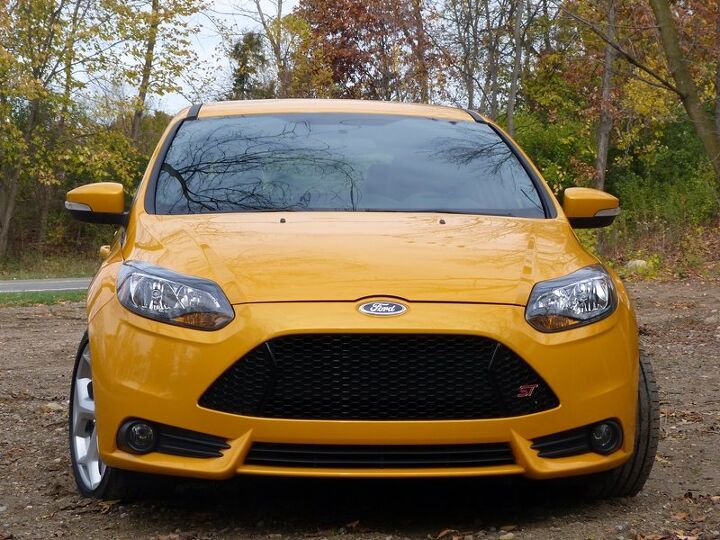




























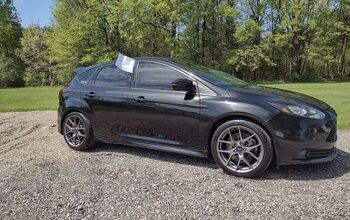

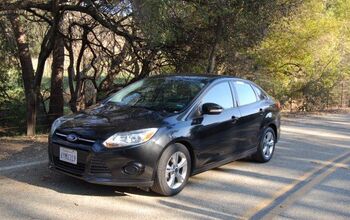
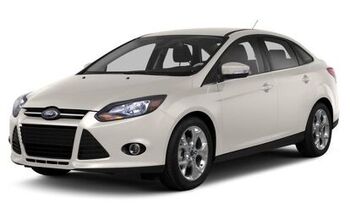
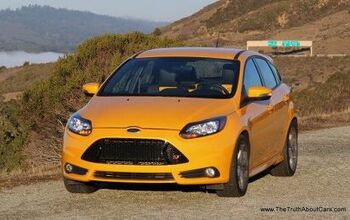










Comments
Join the conversation
R & T has a review of the new GTI and they say it's MUCH better than the Focus ST if it comes to the US in the same form. "If last year’s Focus ST raised the bar in terms of handling, the new GTI has just knocked that bar out of the park....." http://www.roadandtrack.com/car-reviews/first-drives/first-drive-2015-volkswagen-gti-review They also said the GTI seemed like it had 100 more horsepower than the ST. And the GTI is more comely, not so unfortunate-looking as the ST to boot.
I purchased one of these in February, largely because this review made me aware of the car, to replace my Audi A7. I was looking to downsize back to a hot hatch and got it narrowed down to the ST and GTI. I liked the looks of the ST better. After 4,400 miles, I still smile every time I drive the car. Handles smoothly while pottering about town and plenty of fun when I goose it. Although at age 45, I suspect I'm out of the target demo and not goosing anything as much as when I was 25. Minor quibbles. The wheel hop on the 1-2 shift under WOT is pretty bad and ends with a "bang!" Ford should have put a stiffer rear motor mount in there as stock and I'll probably put the E-Focus RMM in at some point over the summer. My Ford Touch is still a little touchy and needs the occasional three finger salute reboot. And the turning circle's pretty big for a small car. Got what I was looking for and think it will hold me off for another 3-4 years until I get the itch to switch again.